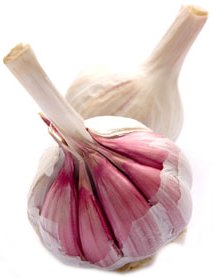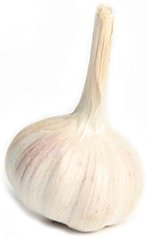

Garlic

Allium sativum. (Liliaceae). Onion-like perennial with strongly aromatic, oily bulbs used for flavouring. The bulb consists of a number of offsets, ‘cloves’. Garlic has a long history of cultivation and is believed to have originated in Central Asia. There is evidence for its cultivation in Egypt before 2000BC. It is now widely grown throughout the world. Garlic cloves are principally used as a flavouring with cooked meats and vegetables. The green leaves can also be finely chopped and used in salads. Bulb formation is like that of onions and occurs in response to increased day length and temperature. In garlic, the process is also influenced by the temperature at which dormant cloves are stored prior to planting. Cool storage at temperatures of 0-10ºC will hasten subsequent bulbing; storage at temperatures above 25ºC may delay or prevent it. Bulbs are dormant in the summer months, when they can be harvested, dried and stored for use through the following winter and spring. An all-year-round supply is feasible where cold storage is available. This crop prefers a sunny site and a light, well-drained soil. Organic matter should be dug into the soil during the winter to improve moisture retention. Plant cloves or whole bulbs during early spring with the nose just below soil level in rows 30-35cm apart with 15cm between plants within the row. Harvest bulbs during the late summer when the foliage dies back; clean and thoroughly dry before tying them into ropes for storage in a cool dry place. Planting during autumn will provide an early summer crop. Improved cultivars include ‘California Early’, fast-maturing, short-keeping; ‘California Late’, very long keeping; ‘Early Italian Red’; ‘Fructidor’; ‘Italian Red’, large bulbs; ‘Silverskin’, strong flavour, good keeper. Top-setting garlics (making bulbils at the top of the stem) include ‘German Red’ and ‘Spanish Roja’. Occasionally attacked by the stem eelworm (Ditylenchus dipsaci) or the caterpillars of the leek moth (Acrolepiopsis assectella), which are small and yellow-green and tunnel into the leaves, otherwise largely pest-free and disease-free.
|
Home
Grow Nuts
Grow Herbs
Grow Fruit
Cyberian Index
If you like this website and want one of your own contact
Cyberian All information correct at
time of publication and open to updates as necessary. No part of this website,
or its vectors, may be produced in any shape or form, using any type or design
of medium, system, equipment or otherwise without the prior written consensual
notice of the Cyberian. Any breach of these requirements will result in the
appropriate action. If in doubt, e-mail contact is recommended.
Some components of this website were obtained as open-source software and are
used in the same non-profit manner on this website.